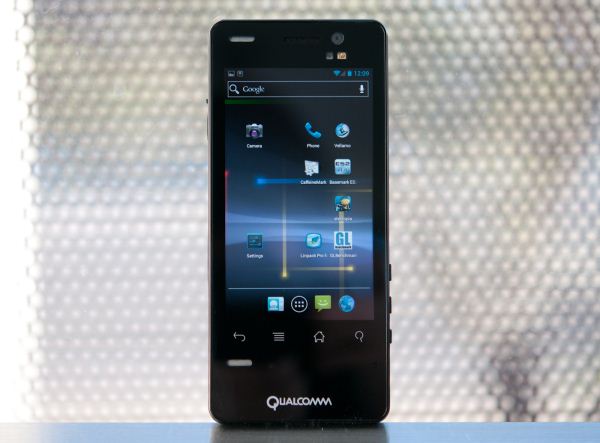Qualcomm Snapdragon S4 (Krait) Performance Preview - 1.5 GHz MSM8960 MDP and Adreno 225 Benchmarks
by Brian Klug & Anand Lal Shimpi on February 21, 2012 3:01 AM EST- Posted in
- Smartphones
- Snapdragon
- Qualcomm
- Adreno
- Krait
- Mobile
Final Words
It goes without saying that MSM8960 is a hugely important SoC release for Qualcomm. It's the first release with Qualcomm's new Krait CPU architecture, an entirely new cellular baseband with support for nearly every air interface, and is manufactured on TSMC's 28nm process. It says something that we're able to hold 28nm TSMC silicon in our hands in the form of the MDP, and it's only a matter of time before we start seeing Krait show up in devices in 2012.
We've gone over basically all of the benchmarks available to us on Android right now, and yet subjective performance impressions are still valuable. The MDP8960 is the absolute fastest we've seen Ice Cream Sandwich thus far - the UI is absolutely butter smooth everywhere, and web browsing in either Chrome or the stock Android Browser is also the smoothest we've seen it. There's no stutter bringing up the application switcher, or taking screenshots, two places that 4.0.3 still drops frames on the Galaxy Nexus.
Krait offers another generational leap in mobile SoC performance. The range of impact depends entirely on the workload but it's safe to say that it's noticeable. The GPU side of the equation has been improved tremendously as well, although that's mostly a function of 28nm enabling a very high clock speed for Qualcomm's Adreno 225. We are eager to see what the Adreno 3xx GPUs that will pair up with future Krait SoCs can do.
The big unknowns today are power consumption and the performance of shipping devices. While we were able to provide power numbers using Qualcomm's handy Trepn tool, we couldn't produce a reference point on older silicon. The move to 28nm and a second generation of cellular basebands has generally been heralded as being the answer to our battery life issues, particularly with LTE. It remains to be seen just how much of an improvement we'll see there. Knowing how much power MSM8960's cellular architecture uses is especially relevant when you consider that MDM9615 includes the exact same modem as MSM8960.
These initial results look extremely promising, however. Krait based devices should begin shipping sometime next quarter, the wait is almost over.











86 Comments
View All Comments
BaronMatrix - Tuesday, February 21, 2012 - link
We can look at the perf of CedarTrail or Ivy Blossom or whatever. Since Intel has said they are more so competing with Qualcomm. And this is only at 1.5GHz. When the 2.5Ghz chips come out with the new Adreno (Former ATi GPU), everyone will have to pack up and go home.iwod - Tuesday, February 21, 2012 - link
The rumors of Apple A5X leads some to suggest next iPad would not be 28nm SoC. So this prove we may still have chance of 28nm SoC coming in next iPad.Krait is bringing A15 level performance while being on a A9 class core?? Sorry i must be missing something. Or Since Krait is designed by Qualcomm A9 and A15 naming doesn't matter? (o.O)
No Mention of comparison to Intel newest Atom?
infra_red_dude - Tuesday, February 21, 2012 - link
Correct, Krait cannot be directly compared to A9 or A15 architecture. I think calling Krait contemporary to A15 is more correct than "A15/9-class" CPU.snoozemode - Tuesday, February 21, 2012 - link
It's really about time you can plug in your mobile to computer screen and run the Tablet UI, preferably at native resolution. Don't know what I would need this processing power to otherwise.tipoo - Tuesday, February 21, 2012 - link
This is very obviously faster than something like the Tegra 3 in single or dual threaded performance, I wonder how many apps take advantage of more than two threads on Android or iOS? I'm guessing for the foreseeable future faster duals will win out.remixfa - Tuesday, February 21, 2012 - link
Can Brian Klug & Anand Lal Shimpi please clarify for me which version of the SGS2 is being used? Its a very pertinent question. Is it the i9000 with the 1.2ghz Exynos chip or the American Hercules T989/Skyrocket variants that have the lesser Snapdragon 1.5ghz chips in them.Judging from the benchmarks, it really makes me think its the hercules/skyrocket. That really needs to be clarified, since unfortunately not all SGS2s are created equal.
Brian Klug - Tuesday, February 21, 2012 - link
The SGS2 used in the article is the UK SGS2 with Exynos 4210 inside.-Brian
larry6hi5 - Tuesday, February 21, 2012 - link
On page 1 of the article, the first table gives the MSM8660 as running at 1.5 GHz. Shouldn't this be 1.0 GHz?Brian Klug - Tuesday, February 21, 2012 - link
That's because the MSM8660 is indeed at 1.5 GHz :)If you go back to our original MDP article we note it there: http://www.anandtech.com/show/4243/
And also the official MDP MSM8660 page: https://developer.qualcomm.com/develop/development...
-Brian
ncb1010 - Tuesday, February 21, 2012 - link
"Even at its lower native resolution, Apple's iPhone 4S is unable to outperform the MSM8960 based MDP here"1024 x 600 = 614,400 pixels
960 x 640 = 614,400 pixels
There is no basis for saying the iPhone 4S has a lower resolution than this MDP being evaluated.